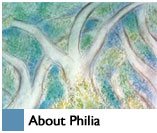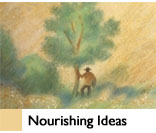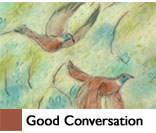Philia in the Classroom
Nourishing Ideas > Philia in the Community > Philia in the Classroom
How Raven Stole the Sun:
Looking at citizenship in a 60-minute lesson plan
By Chris Horrocks
Raise the issue of "creating citizenship" in most school staff rooms, and you will quickly be dismissed as a dreamer (perhaps a teacher on call) - or a religious fanatic - or perhaps someone who holds administrative ambitions. "Creating citizenship" is a grand idea, seemingly light years away from the daily tensions of the classroom.
Don't be too quick to condemn teachers, though. We are perhaps too close to the citizenship dreams we hold as a culture. We see too much of the soft underbelly of community life: the neglect of families, the pain of poverty, and a legacy of false promises as more expectations are placed on us to "do something" with ever fewer resources.
We know we are playing with large, important forces. As a system, however, we have been awkward in the way we have conspired to teach citizenship and the skills of democracy. We in the teaching community find ourselves caught between those who would have us believe that "above all we should avoid the temptation to regard the school as an instrument that can cure all social ills" and those who are impatient with our inaction.
My own sense is that good teachers have always taught citizenship in small ways. But they would be hard pressed to explain how they do it.
As a veteran teacher of over 25 years, I now realize that many of the intricacies and beauties of the teaching craft are not revealed in school district mission statements or ministry directives. Rather, they are present in small teaching moments, in small classrooms. They are a result of the interplay between who the teacher is and the capacity of the classroom and the school. And these moments of artful teaching are always, fundamentally, about creating citizenship.
Let me tell you a story about one of those teaching moments, and link the teacher's decision-making with Philia's underlying beliefs about creating citizenship. My intent here is to push past the soft rhetoric and provide some examples of what these beliefs might call for in terms of real teaching practice.
How Raven Stole the Sun
I am standing in a Grade 3/4 split classroom. This will mean that the teacher's professional responsibilities, above all, will be to take this little band of kids through two sets of prior learning objectives. The Grade 3 parents want to make sure their kids are not being left behind and the Grade 4 parents will insist that the teacher not hold the 4s back by pandering to the Grade 3s. It can be a difficult balancing act.
It is a class of 29 students. Students are engaged in creating puppets and practising their retelling of the First Nations legend, "How Raven Stole the Sun". There is paper on the floor, popsicle sticks are scattered here and there, bits of fabric are trailing out of green garbage bags, and pools of dreaded white glue are oozing on desk tops. It is noisy and chaotic, and every fifteen minutes students approach the teacher to help them solve a group problem.
The teacher reinforces the group process strategies she has been teaching. The groups are a mix of Grade 3 and 4 students, and each group has been hand-picked by the teacher so that they will stand the best chance of getting along and will all have an avenue of contribution. Some will make the puppets, others will rewrite the story, while others will be the storytellers and others will simply dance it.
Darting in and out of the groups is a Grade 3 student named Paul. He has completed his puppet and is moving the bird through the room, swooping it down and then up, calling "caw-caw-caw". Paul lives with autism and each group has recruited him to do the Raven Dance because he truly gets it. This is a great lesson.
How did the teacher manage to create such freedom and coherence? Every learning body is engaged. What is the alchemy and how does it relate to building citizenship?
To be a caring citizen requires us to be in relationship with each other.
In the first term the teacher was in relational process with all 29 students. This process included being fully receptive to who they truly were. This is a difficult task. The relationship is grounded in the context of the larger class, the reputation some students bring with them, and for some, a file. The teacher in this story pushed past the early temptation to have confusing students assessed and taken away to resource room "help". Sending students away at such an early stage was contrary to her own understanding of the early relational process that she needed to establish as their teacher. But her decision to hold back on help was discouraged by the principal and the learning assistance staff.
Relationships provide opportunities for contribution, which is essential to full participation as citizens.
The teacher felt strongly that she needed to have all of her students present in the classroom in order to determine where their strengths lay, so that she could help create paths for contribution in the classroom. It also allows the students to establish a measure of each other so that they can create networks of relationships among themselves.
Our communities are inherently resilient and hospitable.
There is enormous potential within each classroom, but it must be managed. This is a dance of control that a teacher must dance with each group each year. The teacher spoke of a point she gets to each year when she experiences the classroom community she has created as a shared space between teacher and learner. In the beginning she holds firmly to the rudder of what grade level objectives the class will follow, but later she begins to allow more shared decision-making about what might be interesting to explore and how they might do it. With this class she did not get to this point until April. Last year she was able to establish this space by December. It was clear to her that when you establish this balance, the kids take more responsibility for their learning - and for each other.
Enabling the presence, participation and contribution of all citizens benefits not only those individuals but our school communities as a whole.
This educational ideal is attained through curriculum and instructional capacity within the classroom. This teacher called it "developing a caring curriculum". She came to it slowly and suffered many setbacks, retreating often to safer worksheets which, she knew, left out many students. Over time she became better at crafting curriculum that was open to each student's individuality - to what they hear, see and feel. She got better at creating real choice and began to embed adaptations into everything she offered. This strengthened her ability to attune herself to the learning rhythms of her students. She was able to pace her teaching and allow more personal goal-setting for all of them.
In the Aboriginal Studies unit, for example, some students became fascinated with the Aboriginals' experience of making contact with European culture for the first time and created an interactive game for the class. Two other boys became interested in the architecture of Sto:Lo homes and created an entire village. The teacher's unit had grown in unforeseen ways and the entire class benefited from the new knowledge.
A final (slightly daunting) word
The teacher's final word was that this approach is not about strategies, but about something deeper. She watches her class and they teach her about the power of fully accepting each other. She feels that at the heart of creating citizenship is the ability to receive the care of others, including the students. She says it has been about surrendering control.
This is both complex and daunting. It supports the premise of Parker Palmer, who writes that good teaching cannot be reduced to technique, but comes from the identity and integrity of the teacher. It is daunting because I know how difficult it is to teach and take chances. Even with 25 years behind me, I hate being vulnerable in front of students. I know how deplorably easy it is to disconnect from the commitment this teacher has made to her class. I wonder how she keeps going in the face of a system that can barely recognize what she has done.
Maybe we had better keep talking about this.
Bibliography
Gann, L.H. and Peter Duignan. "How Should the US Deal with Multicultural School Children?" Stanford University Campus Report, March 4, 1987.
Noddings, Nel. "The Challenge to Care in Schools: An Alternative Approach to Education", New York: Teachers College Press, 1992.
Palmer, Parker. "The Courage to Teach", San Francisco: Jossey-Bass Inc., 1998.
Chris Horrocks is a learning support teacher at Halls Prairie Elementary in Surrey, British Columbia. He also teaches at Douglas College in New Westminster in the Faculty of Community, Family and Child Studies and is a sessional instructor at the University of British Columbia where he instructs inclusion methodology.
 |
Feb 23, 2021
11:49 AM |
philia in the classroom |
| vickie cammack |
Great article by Chirs Horrocks. It captures the simplicity and the complexity of fostering caring citizenship. |
|






